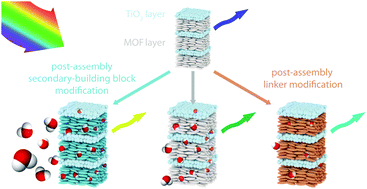当前位置:
X-MOL 学术
›
Nanoscale Horiz.
›
论文详情
Our official English website, www.x-mol.net, welcomes your
feedback! (Note: you will need to create a separate account there.)
Improving analyte selectivity by post-assembly modification of metal–organic framework based photonic crystal sensors†
Nanoscale Horizons ( IF 8.0 ) Pub Date : 2018-03-16 00:00:00 , DOI: 10.1039/c7nh00209b A. von Mankowski 1, 2, 3, 4, 5 , K. Szendrei-Temesi 1, 2, 3, 4, 5 , C. Koschnick 1, 2, 3, 4, 5 , B. V. Lotsch 1, 2, 3, 4, 5
Nanoscale Horizons ( IF 8.0 ) Pub Date : 2018-03-16 00:00:00 , DOI: 10.1039/c7nh00209b A. von Mankowski 1, 2, 3, 4, 5 , K. Szendrei-Temesi 1, 2, 3, 4, 5 , C. Koschnick 1, 2, 3, 4, 5 , B. V. Lotsch 1, 2, 3, 4, 5
Affiliation

|
The porous nature and structural diversity of metal–organic frameworks (MOFs) provide a versatile platform for specific and selective sorption behavior. When integrated as functional layers into photonic crystals (PCs), loading of the porous network with organic solvent vapors translates into an optical response, allowing analyte discrimination according to the specific host–guest interactions and, hence, framework affinity to the analytes. However, the optical response of PCs is critically influenced by the overall PC architecture, leading to batch-to-batch variations, thus rendering unequivocal analyte assignment challenging. To circumvent these problems, we have developed a straightforward and mild “post-assembly” modification strategy to impart differences in chemical selectivity to the MOF layers whilst keeping the overall PC backbone constant. To this end, one-dimensional photonic crystal (1D PC) sensors based on CAU-1 and TiO2 layers were fabricated to obtain a generic platform for post-assembly modification, targeting either the secondary building unit (SBU) or the linker unit of the as-assembled MOF nanoparticle layers. The optical response to solvent vapor exposure was investigated with the pristine CAU-1 based sensor as well as its modifications, showing enhanced analyte selectivity for the post-modified systems.
中文翻译:

通过对基于金属有机框架的光子晶体传感器进行组装后修改来提高分析物的选择性†
金属有机框架(MOF)的多孔性质和结构多样性为特定和选择性的吸附行为提供了一个多功能的平台。当作为功能层集成到光子晶体(PC)中时,有机溶剂蒸气在多孔网络中的负载会转化为光学响应,从而可以根据特定的主体与客体之间的相互作用来区分分析物,从而使框架对分析物具有亲和力。但是,PC的光学响应会受到整个PC架构的严重影响,从而导致批次之间的差异,从而使明确的分析物分配面临挑战。为了避免这些问题,我们开发了一种简单而温和的“后组装”修饰策略,以赋予MOF层化学选择性差异,同时保持整个PC主链恒定。为此,基于CAU-1和TiO的一维光子晶体(1D PC)传感器制造2层以获得用于组装后修饰的通用平台,目标平台是组装后的MOF纳米颗粒层的次要构建单元(SBU)或连接单元。使用基于原始CAU-1的传感器及其修饰物研究了对溶剂蒸气暴露的光学响应,并显示了对修饰后系统增强的分析物选择性。
更新日期:2018-03-16
中文翻译:

通过对基于金属有机框架的光子晶体传感器进行组装后修改来提高分析物的选择性†
金属有机框架(MOF)的多孔性质和结构多样性为特定和选择性的吸附行为提供了一个多功能的平台。当作为功能层集成到光子晶体(PC)中时,有机溶剂蒸气在多孔网络中的负载会转化为光学响应,从而可以根据特定的主体与客体之间的相互作用来区分分析物,从而使框架对分析物具有亲和力。但是,PC的光学响应会受到整个PC架构的严重影响,从而导致批次之间的差异,从而使明确的分析物分配面临挑战。为了避免这些问题,我们开发了一种简单而温和的“后组装”修饰策略,以赋予MOF层化学选择性差异,同时保持整个PC主链恒定。为此,基于CAU-1和TiO的一维光子晶体(1D PC)传感器制造2层以获得用于组装后修饰的通用平台,目标平台是组装后的MOF纳米颗粒层的次要构建单元(SBU)或连接单元。使用基于原始CAU-1的传感器及其修饰物研究了对溶剂蒸气暴露的光学响应,并显示了对修饰后系统增强的分析物选择性。











































 京公网安备 11010802027423号
京公网安备 11010802027423号